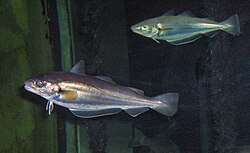| Merlangius merlangus | |
|---|---|
 | |
| Scientific classification | |
| Kingdom: | Animalia |
| Phylum: | Chordata |
| Class: | Actinopterygii |
| Order: | Gadiformes |
| Family: | Gadidae |
| Genus: | Merlangius Garsault, 1764 |
| Species: | M. merlangus |
| Binomial name | |
| Merlangius merlangus | |
| Synonyms | |
Merlangius merlangus, commonly known as whiting or merling, is an important food fish in the eastern North Atlantic Ocean and the northern Mediterranean, western Baltic, and Black Sea. In Anglophonic countries outside the whiting's natural range, the name "whiting" has been applied to various other species of fish.

